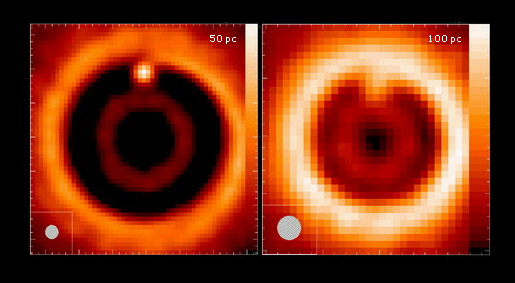Star and planet formation
Star formation is the mechanism which controls the structure and evolution of galaxies, the buildup of heavy elements in the Universe, which is responsible for the creation of planetary environments in which life is possible.
Stars shine for billions of years, but their formation – which takes only a few million years – remains, literally, a mystery: optical telescopes cannot observe inside the dusty clusters of gas where stars are born. On the other hand, infrared telescopes that can reveal infant stars before they completely emerge from their dusty cradles, are not able to observe the development process involved in the pre-ignition of stars.
We know that these huge clouds collapse under for force of gravity to form stars. Due to nuclear fusion, these early stars converted hydrogen and helium into other elements such as carbon, oxygen, silicon and iron. At the end of their short lives, the first stars ejected these elements into space, where they gave shape to tiny grains of dust. ALMA can detect this dust from the early Universe, which is present in the most distant and ancient galaxies, thanks to submillimeter wavelengths. It provides information on the process of formation of these early stars and galaxies.
We know that star formation involves gravitational collapse, but in-fall motions forming a new star have yet to be found. To observe certain evidence of collapse, we require a high-velocity spatial resolution (to map the velocity field across small structures) that is highly sensitive (to take full advantage of the high-velocity spatial resolution). Furthermore, this observation must be available at a wavelength at which the collapsing object emits, and at which the surrounding material is transparent. Of current instruments, only ALMA has the characteristics required to reveal these mysteries, by observing, in depth, star-forming clouds and detecting the soft light emitted by matter which is just beginning to warm up, and even mapping its movement.
According to our current knowledge, planets are formed around a new star by condensing in a disc of molecular gas and dust, embedded within a larger molecular cloud. Condensation increases until they become giant planets, which are heated, then cleanse their orbits in the disc and possibly bend it. Remaining gas in the disc finally disappears, leaving planets, a disc of dust and debris.
ALMA studies all phases of planet forming: it probes protoplanetary discs – planetary embryos – at high resolution; it can capture the increasing brightness and temperature of planets in the process of formation and directly detect how giant planets cleanse their orbits within the discs. ALMA can find more planets by measuring the tiny effects over the stars they orbit and allows measuring the mass of these planets under formation. Moreover, ALMA can examine discs of dust and the debris that remain around stars once the gas has disappeared.
A simulation (Wolf & D'Angelo 2005) of ALMA observations at 950 GHz of a disc shows an embedded protoplanet of 1 Jupiter Mass around a 0.5 Solar Mass star (orbital radius: 5AU). The assumed distance is 50 pc or 100 pc as labeled. The disc mass is set to that of the Butterfly Star (IRAS 04302+2247) in Taurus. Note the reproduced shape of the spiral wave near the planet and the slightly shadowed region behind the planet in the left image. Image courtesy S. Wolf.

